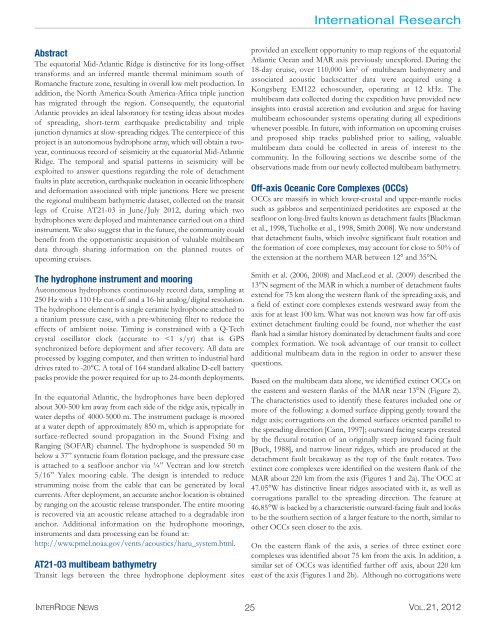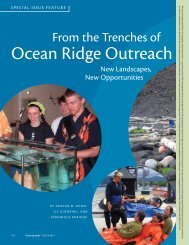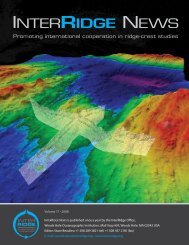Full version, low resolution, 7.5MB - InterRidge
Full version, low resolution, 7.5MB - InterRidge
Full version, low resolution, 7.5MB - InterRidge
You also want an ePaper? Increase the reach of your titles
YUMPU automatically turns print PDFs into web optimized ePapers that Google loves.
International Research<br />
Abstract<br />
The equatorial Mid-Atlantic Ridge is distinctive for its long-offset<br />
transforms and an inferred mantle thermal minimum south of<br />
Romanche fracture zone, resulting in overall <strong>low</strong> melt production. In<br />
addition, the North America-South America-Africa triple junction<br />
has migrated through the region. Consequently, the equatorial<br />
Atlantic provides an ideal laboratory for testing ideas about modes<br />
of spreading, short-term earthquake predictability and triple<br />
junction dynamics at s<strong>low</strong>-spreading ridges. The centerpiece of this<br />
project is an autonomous hydrophone array, which will obtain a twoyear,<br />
continuous record of seismicity at the equatorial Mid-Atlantic<br />
Ridge. The temporal and spatial patterns in seismicity will be<br />
exploited to answer questions regarding the role of detachment<br />
faults in plate accretion, earthquake nucleation in oceanic lithosphere<br />
and deformation associated with triple junctions. Here we present<br />
the regional multibeam bathymetric dataset, collected on the transit<br />
legs of Cruise AT21-03 in June/July 2012, during which two<br />
hydrophones were deployed and maintenance carried out on a third<br />
instrument. We also suggest that in the future, the community could<br />
benefit from the opportunistic acquisition of valuable multibeam<br />
data through sharing information on the planned routes of<br />
upcoming cruises.<br />
The hydrophone instrument and mooring<br />
Autonomous hydrophones continuously record data, sampling at<br />
250 Hz with a 110 Hz cut-off and a 16-bit analog/digital <strong>resolution</strong>.<br />
The hydrophone element is a single ceramic hydrophone attached to<br />
a titanium pressure case, with a pre-whitening filter to reduce the<br />
effects of ambient noise. Timing is constrained with a Q-Tech<br />
crystal oscillator clock (accurate to
















